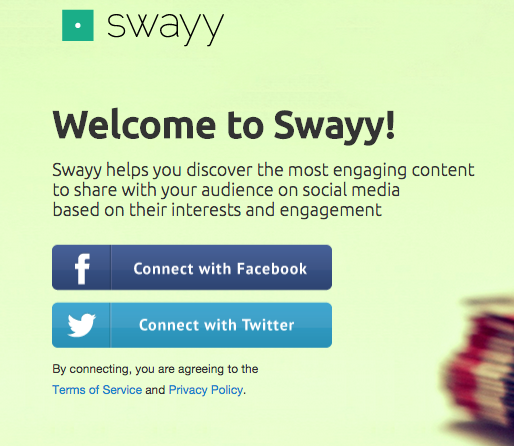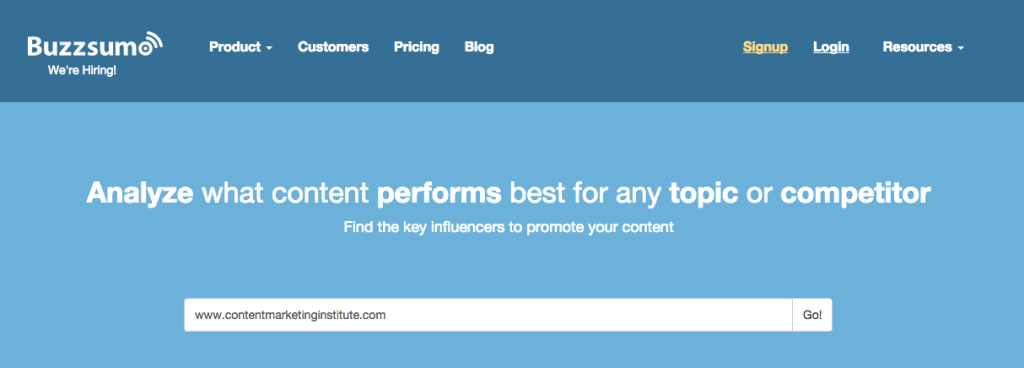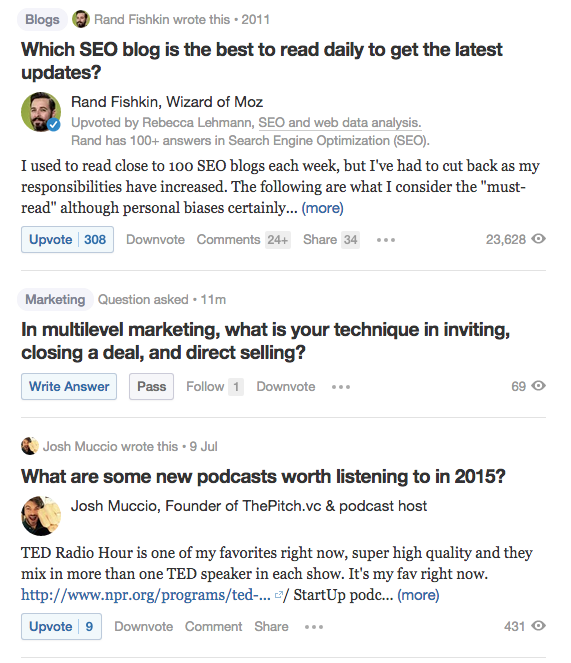Finding new content ideas for your audience is hard.
I mean, you probably have hundreds of ideas rolling around in the back of your head right now. But, it’s just finding where you left the darn key to that door, isn’t it?
Plus there are all the questions that hang over your head:
- Is this a good idea?
- How well will the post perform?
- Is this even a post my audience want?
And it doesn’t matter if this is a for a blog post you’re creating yourself, or whether you’re just looking for something new to share on Twitter…it’s always in the back of your mind.
Well, today, you’re going to put those questions to bed.
You’ll see how to create a rock solid content creation (or sharing) system that will make finding and creating content easier and less stressful than ever.
Note: I’ve written this post as if you’re creating a blog post with it. But, if you’re just looking for valuable content to share with your audience on Social Media, just share the content you find with this system, instead of writing it.
Part #1: Create A No-Fail Content Guideline
This analysis is something I first learned about from the wonderful minds over at Canva.
And, it works an absolute charm.
In fact, from just getting to know their audience better, they managed to boost their own blog traffic 226% in three months.
Basically, you’re going to look at the common themes between the pieces of content your audience shares and create a set of guidelines for your own content.
It sounds complex, but it’s actually super simple. All you need to know is:
- Which sites your audience is reading from
- What topics they care about most
- How these posts are different to yours
You can do this quite quickly, too. So let’s break it down into little steps you can work with as you go:
Step #1: Get Swayy
To save time, I did this whole process for the Share As Image blog using Swayy.
Simply connect using your channel with the most engaged followers (for us it was Twitter):

Let Swayy perform some sort of Harry Potter wizard magic that analyses all of your followers. Leaving you with a list of topics they’re talking about:

And all of the content they’re sharing, too:

Now, not only do you have a whole list of topics worth talking about, you also have a cheat sheet filled with ideas for your next piece of content.
Step #2: Choose The Content From Your Biggest Competitors
There are going to be names on this list that you recognise, because they’re in the same part of the blogosphere as you. Or, because you’re a super-fan. Either works.
These are the blogs you want to focus most of your time on. And the more they crop up, the more attention you should pay. For example, The Content Marketing Institute play a big role on our feed, which meant we factored them into our analysis:

Take note of some of the content on these sites (and dig a little deeper into their site for the evergreen content too) and open them all up in different tabs.
Step #3: Look For Similarities
Okay, this is where stuff starts to get interesting. And the better the content you’re looking at, the richer your guidelines are going to become.
Here’s what you need to be looking for:
- Word Count
- Images Used
- Tone of voice
- Comments and Questions
From there, you can begin to flesh out your guidelines (as I’ll show you in the next step).
But there is one thing I’d like to mention here:
Look for deeper connections between articles.
For example, in my research for you lovely readers I discovered that there was one big arc tying together most of the content you like to read – Productivity. Because, you can always use more time, right?
So be sure to look for an umbrella topic that covers everything you’re researching.
Step #4: Build Your Guidelines
By this step you’re going to have a ton of information on what your audience is looking for in a blog post.
Which means it’s time for you to start putting together your guidelines. Which should look a little bit like this:

Now your guidelines are going to look completely different to mine, because this is your audience we’re talking about. But what matters is that you now have these in place and you can choose your topics from a place of data driven knowledge.
So now, when you have an idea or go looking for new content you’re able to decide whether this post will perform well, or whether it will absolutely tank.
Part #2: Use BuzzSumo To Steal Find What’s Hot
Okay, I’m going to be straight up here:
I’m going to ask you to do some stealing.
But, it’s honest, wholesome, artistic stealing that has been used for hundreds of years. And now it’s your time to use it too.
You’re not going to be ripping people off though. I just want to make that super-abundantly-crystal-clear. This isn’t that kind of stealing.
You’re just going to be giving your perspective on already proven ideas. Basically understanding what’s hot, and why.
Plus, you want to create content with less risk and more return, don’t you?
Well let’s look at how you can do that:
Search Your Competitors And Find Your Ideas
In the last section you looked at who your competitors were – the ones that showed up most often in Swayy – and the similarities in their content.
Now you’re going to look at which topics of theirs are performing the best, by searching for them in BuzzSumo.

Which will bring up a list of their highest performing content over the last year.
Now if you’re on the free platform, you’ll only be able to see a few topics (trust me, it’s enough) so I’d recommend playing around with the side-bar filters and adding keywords of topics, like:
www.sitename.com “topic”
Like I did to get some productivity ideas, right here:

But what you’re looking for is high performing content ideas. Which is indicated by the amount of shares down the right hand side.
From there, have a read of those posts and see what you think. Is this a piece that:
- Adds value to your audience?
- You could improve and give more details on?
- You have personal experience with?
- Fits your guidelines?
If so, think about how you can create it from your own perspective, in your own words and grow the conversation around the topic.
Wash. Rinse. Repeat. Until you have enough ideas to keep your blog topped up for the coming weeks.
Part #3: Just, Y’know…Ask Them
There’s a lot to be said for just talking to your audience, building a relationship and finding out what it is that they’re looking for.
Now, I’m not saying that if TV writers had asked an audience what they wanted to see, they would have come back with the idea for a cancer stricken, Meth dealing Chemistry teacher from New Mexico. That would be a little too specific.
But they probably would have come back with something surrounding drugs or crime or debauchery, because those are topics that have worked in TV for years.
The same can be said for asking them for content ideas.
They probably wont come back to you saying, “I’d love to see an article about 10 ways you can use deodorant as an insect repellent”. Or, anything quite that specific. But they’ll come back to you and talk about topics they’d like to see more of. Or less of.
So, how do you ask your audience what it is that they’re looking to see? Well, there are two ways to go about it:
- Directly: Through email, social media and surveys.
- Indirectly: Through looking at the questions they’re asking across the Internet.
How To Ask Directly
You know your audience far better than I do, so I’m not going to give you anything too specific for this. You’ll know the right way to ask the question.
But all you’re really going to ask is:
“Hey,
I’m looking to find out how I can find even more epic content for you to read. I was just wondering, what sort of topics are you interested in? Is there anything you’d like to know more of, or read more about?
Cheers,
[Your name]”
You can do this short and sweet through social media:

Or you can send out an email, or survey link, asking your audience to give a little bit of input in that way too.
Now, this can feel daunting, but don’t worry, nobody is going to come back at you shouting. They’ll either give you some new ideas…or not say anything. Either way, you’ve not lost anything.
How To Ask Indirectly
You’re not really asking here. You’re just answering questions that people have asked on the internet that fit your audience well.
A great place to do this on Quora.
Simply sign up, choose the relevant topics for your blog (or social media feed) and take a look at the hot questions:

Or you can dig a little deeper and find the more complex questions too. Either way, you’ve got an abundant source of content ideas that fit your audience, and you’ve had to do little to no brainstorming to get there.
Neat, huh?
Over To You…
By now you should have a good idea of where to start, and what you need to do, to find content that’s not only fresh and new but tried and tested, too.
Research is your best friend as a content marketer, and the more time you can spend in this stage – finding and creating ideas – the easier your job becomes in the long run. And, the more informed your decisions, the better your results.
So, where are you going to start?


Great summary post. I love using all of these tools already to find great content to share. Going on Swayy is a daily routine, I use it the most out of everything you mentioned.
Thanks for the kind words, Tahir! What site are you creating content for?
My main project right now is uxjobs247.com Use Swayy to find some great content to share and comment on. Use Share as Image for weekly posts on Fridays.
Enjoy your information. I also love Canva! My favorite. And, I do agree – ask people and you will get some great ideas, this is no place to be shy. And will have to look into Swayy – I’ve heard of it, but never used it. Love your blog. Thanks for sharing.
Thanks for your support, Laurie! Glad to have you on board 🙂
My pleasure! Enjoy the weekend.
Swayy is close now, no?
Unfortunately yes, I had totally forgotten about that. It was good. I’ll be trying out Prismatic.